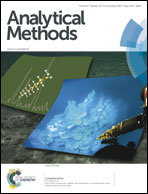Determination of cadmium in Zircaloys by electrolyte cathode discharge atomic emission spectrometry (ELCAD-AES)
Abstract
An electrolyte cathode discharge atomic emission spectrometric (ELCAD-AES) method has been reported for the determination of cadmium in Zircaloys. Formic and acetic acids are examined to improve the sensitivity of ELCAD-AES for cadmium determination. The sensitivity of ELCAD-AES is improved 2-fold with 20% (v/v) formic acid. With 20% (v/v) formic acid, the improved detection limit of ELCAD-AES for cadmium is found to be 2 ng mL−1. A previously reported matrix separation procedure using ammonium pyrrolidine dithiocarbamate (APDC) and methylisobutylketone (MIBK) for the extraction of Cd from Zirconium matrices has been optimised for ELCAD-AES analysis of cadmium. This procedure is found to be useful for the quantitative determination of cadmium in Zircaloys by ELCAD-AES. The precision expressed as a percentage relative standard deviation of the signals of multiple analyses (N = 5) of ELCAD-AES method using the above matrix separation procedure has been found to be 10–15% for trace Cd. This ELCAD-AES method is validated with the certified values of Zircaloy CRM and the glow discharge quadrupole mass spectrometry (GD-QMS) values of Zircaloy samples.


 Please wait while we load your content...
Please wait while we load your content...